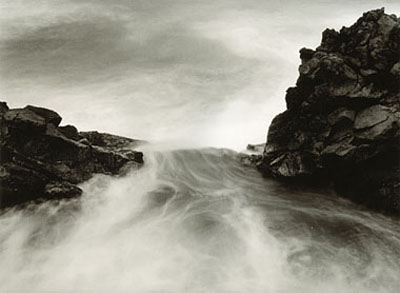 Furthest North - The Mid North Atlantic Ocean Faro de Alegranza, Punta Delgada, Lanzarote, The Canary Islands, Spain Near the North-most point of The Canarian Archipelago, 2002 Silver gelatin print, 102 x 137 cm Thomas Joshua Cooper point of no return Click for English text Thomas Joshua Cooper (1946 in Kalifornien geboren) zählt weltweit zu den meist gefeierten und charakteristischsten Landschaftskünstlern und Photographen. "point of no return" wurde erstmals bei Haunch of Venison, London, gezeigt und darf seit seiner Ausstellung in der Serpentine Gallery 1989 als wichtigste Präsentation von Coopers Photographien in Grossbritannien bezeichnet werden. Seit 1969 verwendet Cooper für seine Arbeiten eine "Feldkamera aus dem 19. Jahrhundert", mit welcher er moderne Landschaften in Form von auserlesenen schwarz-weiss Photographien aufnimmt. Diese lassen sich in die Tradition der grossartigen Pioniere der amerikanischen Photographen, wie beispielsweise Timothy H. O'Sullivan, einordnen. Die Arbeit beginnt Cooper mit der Suche nach einem Ort auf der Weltkarte, über welchen er Nachforschungen anstellt, diesen anschliessend aufspürt und schliesslich das ausgesuchte Objekt ablichtet. Von jedem einzelnen Standort fertigt er jedoch nur eine Ansicht an. Ausgeführt werden die Bilder in Silver Print, Schichten aus Selen und Gold Chlorid. 1990 beginnt Coopers mit seinem ehrgeizigsten Projekt "The World's Edge - The Atlantic Basin Project", in welchem er die markantesten Punkte von Festland und Inseln im Atlantik abbildet. Die Ausstellung von Haunch of Venison "point of no return" markiert mit der Präsentation von Photographien, welche den westlichsten, nördlichsten und südlichsten Punkt der beiden Kontinente Europa und Afrika darstellen, den Abschluss des ersten Teils dieses Projektes. Die Ausstellung beinhaltet mehr als 30 Werke, welche in über 10 Ländern inklusive Marokko, Senegal, Südafrika, Spanien und Norwegen gemacht wurden. In Coopers Werk wird die Natur sowie die Bedeutung der Menschheit innerhalb dieser thematisiert. Die Werke erforschen die Grenzen der menschlichen Zivilisation, hinsichtlich Zeit und Raum. Michael Govan, Direktor der Dia Art Foundation schreibt: "Coopers eigenes Leben bildet die Vielfalt einer Epoche, welche mit Erdkunde bereits vertraut, kulturelle und persönliche Identifikation jedoch stetig verändert, nur um auf dem für uns begrenzt wahrnehmbaren Globus erneut abgebildet zu werden. Seine Kunst ist Ausdruck einer nicht enden wollenden Erforschung der Grenzen unserer eigenen menschlichen Identität, wie heute beispielsweise eine Reise voller Unsicherheiten und Risiko..." Cooper wuchs im ländlichen Wyoming, in New Mexico, North Dakota, Kalifornien und Oregon auf. Er studierte Kunst, Literatur und Philosophie, 1972 mit einem Hochschulabschluss in Kunst, bevor er in England, Amerika und Tasmania unterrichtete. Er ist Professor und Senior Forscher für Kunst an der Glasgow School of Art. Cooper's Werk ist weltweit in zahlreichen öffentlichen Sammlungen, einschliesslich des Art Institute in Chicago, dem Boston Museum of Fine Art, dem Museum of Fine Arts in Houston und der Tate Collection. Coopers Werke wurde seit 1971 in über 50 Einzelausstellungen quer durch Europa und Amerika gezeigt. Die Ausstellung wird von einem Buch mit einer Abhandlung von Duncan Macmillan, Professor für Kunstgeschichte an der Universität von Edinburgh begleitet. Ebenfalls in diesem Buch publiziert, ist ein mit dem Künstler geführtes Interview von Kunstkritiker Nick Hackworth. Ausstellungsdauer: 4.2. - 12.3.2005 Oeffnungszeiten: Di-Fr 14 - 18.30 Uhr, Sa 11 - 16 Uhr Galerie Judin Lessingstrasse 5 8002 Zürich Telefon 043 422 88 88 Email info@galeriejudin.ch www.galeriejudin.ch Thomas Joshua Cooper point of no return Thomas Joshua Cooper (born California 1946) is one of the world's most celebrated and distinctive landscape artists and photographers. This exhibition his the artist's first presentation in Switzerland. From 1969 Cooper has worked with a nineteenth-century field camera, mapping the modern landscape in exquisite black and white photographs in the tradition of the great pioneers of American photography such as Timothy H. O'Sullivan. Each work begins as a location found on a map, researched, tracked down and then the picture is made. Each site, the subject of a single frame. Cooper then makes silver prints of the images with layers of selenium and gold chloride. Cooper's most ambitious project is "The World's Edge - The Atlantic Basin Project", an epic endeavour begun in 1990 to map the extremities of the land and islands that surround the entire Atlantic Ocean. Our exhibition, "point of no return", marks the completion of Part I of this project, with the first showing of photographs mapping the western, northern and southern points of the continents of Europe and Africa. The exhibition includes more than twenty works made in over ten countries including Morocco, Senegal, South Africa, Spain and Norway. Cooper's work is about nature and humanity's place within it. The works explore the boundaries of human civilization, both temporal and physical. Michael Govan, Director, Dia Art Foundation has written: "Cooper's own life is a composite of an era where geography is known, but cultural and personal identities are continually shifting, only to be remapped on our perceived finite globe. His art is an expression of the never-ending exploration of the edges of our own human identity, a journey that today remains fraught with uncertainties, or even peril...". Cooper grew up in rural Wyoming, New Mexico, North Dakota, California and Oregon. He studied art, literature and philosophy, obtaining a Master's degree in fine art in 1972, before teaching in England, the US and Tasmania. He is Professor and Senior Researcher for Fine Art at Glasgow School of Art. Cooper's work is in numerous public collections worldwide including the Art Institute of Chicago, Boston Museum of Fine Art, the Museum of Fine Arts in Houston and the Tate Collection. Cooper has held over fifty solo exhibitions since 1971 across Europe and America. The exhibition is accompanied by a book with an essay by Duncan Macmillan, Professor of Art History at the University of Edinburgh. An interview with the artist by art critic, Nick Hackworth, is also published in the book. In association with Haunch of Venison, London. Exhibition: February 4 - March 12, 2005 Gallery hours: Tues-Fri 2 - 6.30 pm, Sat 11 am - 4 pm |